Gordon Cook
![]()
Gordon Cook |
|
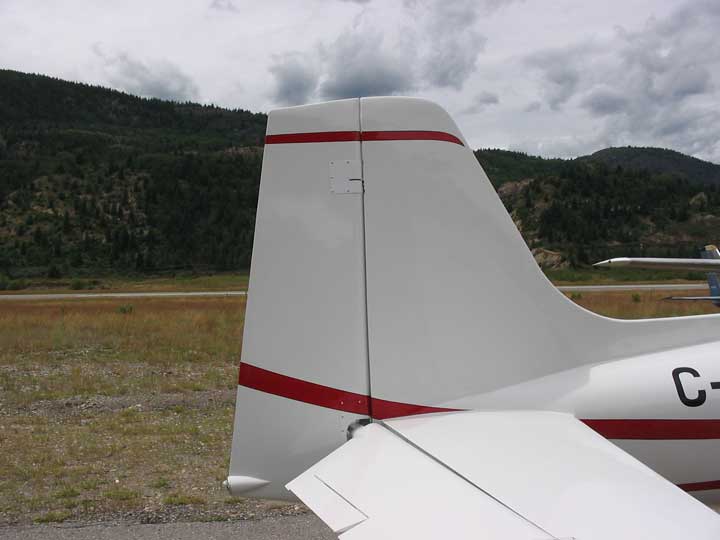
The rudder fairings |
It had to be the transistor. I had it checked by an electronics firm on their magic machine, and they said there was nothing wrong with it. I dummied up the circuit at home with the transistor and resistors for the base input and the load and found 7.5 volts across the load resistor. The only difference between the aircraft and home was that the power supply I used was 13.8 volts and the aircraft battery was 12.5 volts, so all along it was a low-voltage condition that was causing the problem, if you call 12.5 volts low. After charging the battery up to 13.8 volts all was well. I have designed a fail-safe circuit to allow testing of the retraction system while on jacks. When the double-pole, double-throw switch is operated to test the gear, one side of the switch places a short across the pitot pressure switch to allow the operation of the gear circuit and the other side opens engine starting circuit. It’s now time for the past 24 years or so of work to be put to the test. After Rick fired up the engine, he taxiied slowly to the run-up area, did his run-up tests then taxied on to runway 34 and out of sight of us who were watching. I couldn’t see, but could hear the engine rev up and then she came into sight, then off the ground and flying. It was hard to believe that the machine I had labored over, cussed at and got such a sense of satisfaction from for all these years, was now flying. |
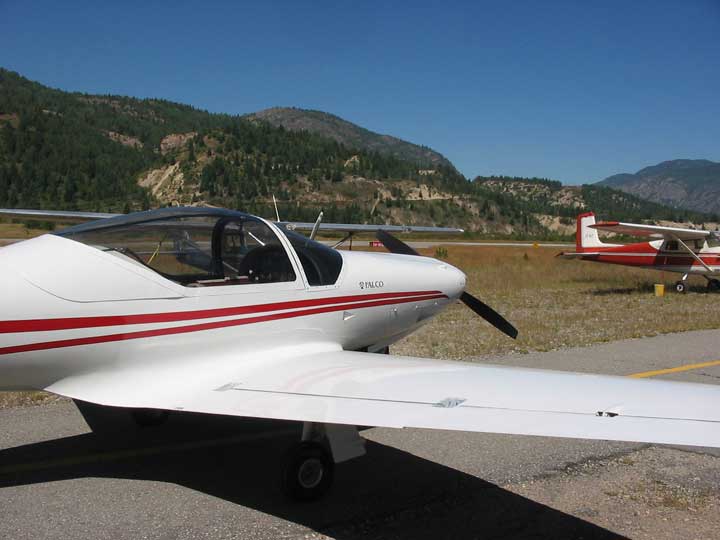
Rick’s test plan was to keep the speed below about 90 knots after take off, fly the circuit and when on final, if all was well, put the gear and flaps up, apply full power and climb to about 5000 ft. Since the engine has many new parts including rings it needed to be run hard for about 25 minutes. It was a relief, when on final, we saw the gear retract, and he announced the climb would start. He kept us informed throughout the test flight, by radio, of how things were going. Those of you that have had the experience of seeing the airplane you built yourself lift off the ground and fly know it’s difficult to find words to describe the feeling, but I’ll try. At lift-off the feeling of extreme apprehension was front and center and would remain until he raised the gear, applied full power and started the climb. I wasn’t aware of anything or anyone except the little white and red airplane and praying the aviation gods would look kindly upon her and her pilot. The higher he got the more the apprehension lifted and the feeling of euphoria and excitement took over. When he announced the indicated speed in level flight at full power I could scarcely take it in. Did I not hear him correctly? Everyone else heard the same thing so it must be so—fantastic. At about 5000’, level flight and full power it indicated 170 knots or about 195 mph. When he said he would do tight turns in both directions the apprehension started to rise again. He was about 1/2 mile south of the airport at about 5000’ when he did his first turn and the tops of both wings were clearly visible as if we were looking down on the aircraft. The turn in the other direction was as if we were underneath looking up. The turns were that tight. Again no problems and the apprehension subsided and excitement grew. With about 3/4 fuel, a 180 lb. pilot and 20 degrees of flap the stall came at 55 knots with a gentle pitch forward. Clean with the same load it stalled at 60 knots. I haven’t yet installed the rudder fairings so I may get a little more speed when that’s done. Then there’s the spinner-cowling gap and the engine cooling openings to be looked at. |
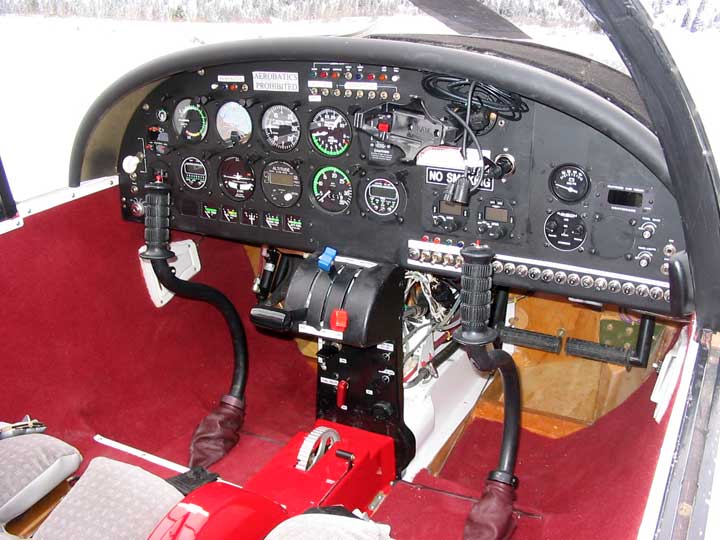
He was up for about an hour, but then came time for the little bird to come home to roost. The thought crossed my mind that since everything had gone so well it would only be fitting if the first landing was a “greaser”, and it was. There were hugs and handshakes all around and my heart rate finally dropped below the cardiac arrest zone. He was up for about an hour then came in for a picture-perfect landing. He reported that the rudder needs a little tweaking even though it flies straight with feet off, the pedals aren’t quite even. One wing is a bit heavy so that will need an adjustment. Other than that he says don’t touch it. Like all Falcos it’s slippery on the descent, but very well behaved. Even though the plane has landed long ago, I haven’t. Maybe in a week or two. |
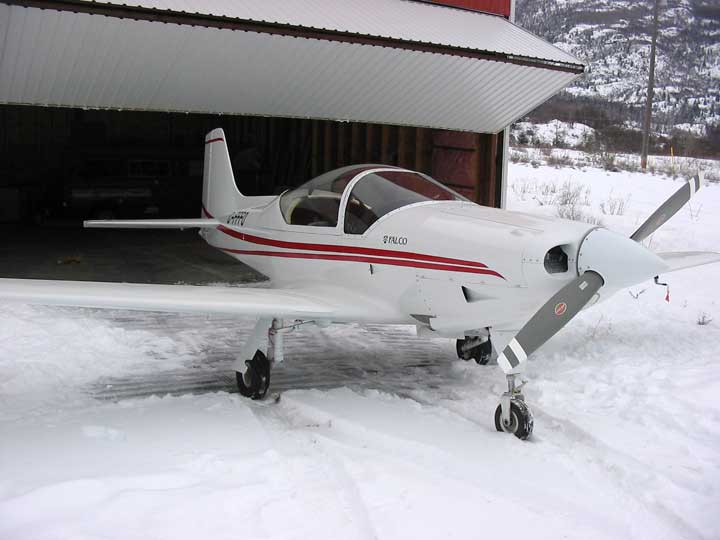
December 2006 saw a new career open up for me... well, a part-time volunteer position at least. April 2006 saw the inaugural flight of a scheduled airline service provided by Pacific Coastal Airlines into the Trail airport. Volunteers were needed to pass weather, barometer readings and runway info to the incoming flights of the Beechcraft 1900’s, plus handle baggage and and other little chores that need doing from time to time. I wasn’t in on it from the beginning, but one of the originals got sick in November ’06 and I was asked to fill in for a while. As with most volunteer positions “for a while” means from now on, but I enjoy it and it keeps me out of mischief. Thanks to all who have helped me with this huge undertaking and lifelong dream—the neighbors in Surrey who were always there to lend a hand—Rob Carey, my mentor from the early days of construction—Bruce Langille, whose truck and trailer brought the Falco to Trail—Phil Maloy, our local AME, who helped me with engine related problems—Larry Levesque, in whose hanger the Falco resides—Rick Scott, who put the icing on the cake by test flying the airplane—and my wife Doreen who put up with me and the airplane for the past 24 years. I’ve not mentioned many who also helped, and although not named, their contribution is certainly valued and appreciated. |
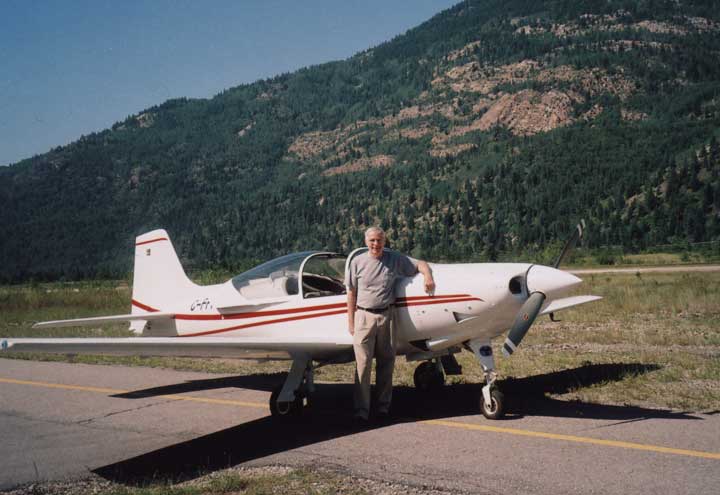
Me and my Falco |
|
|